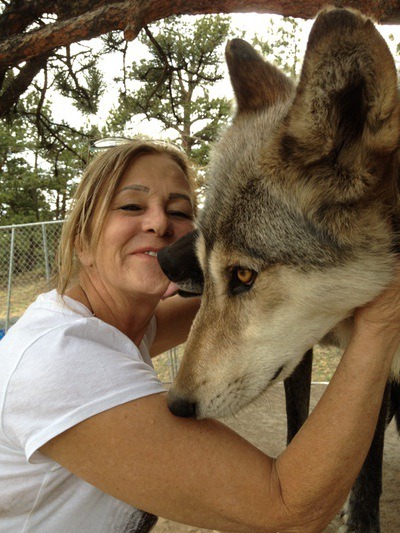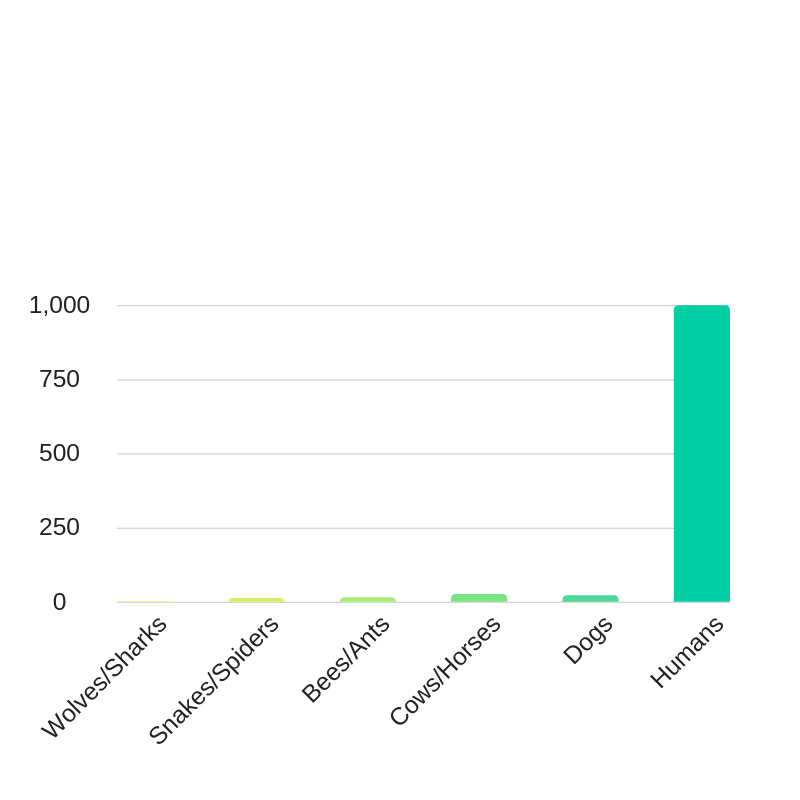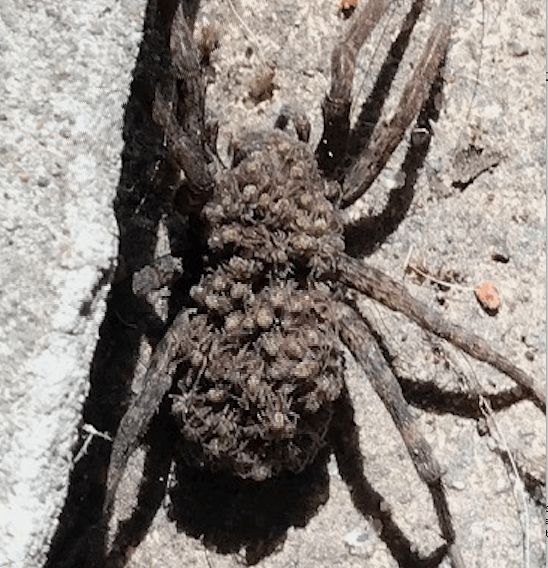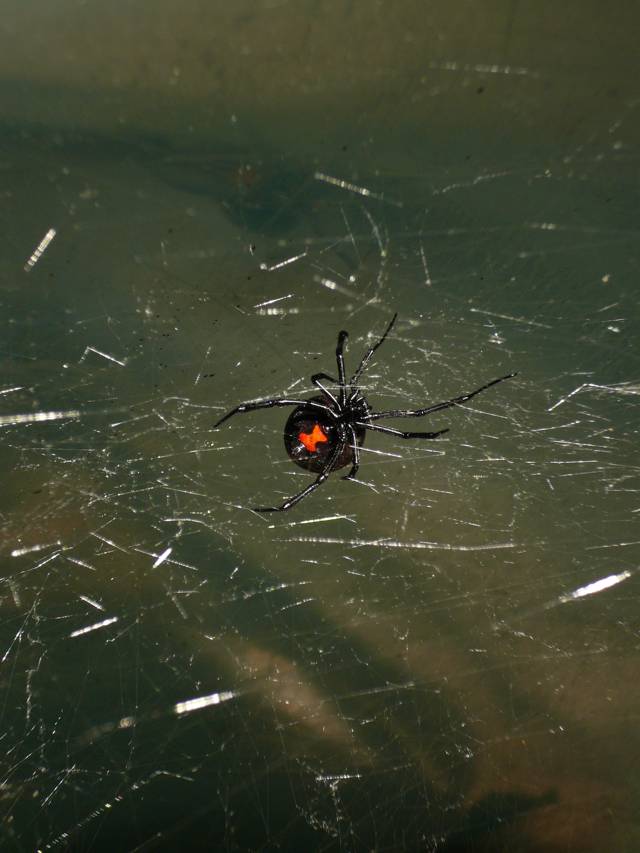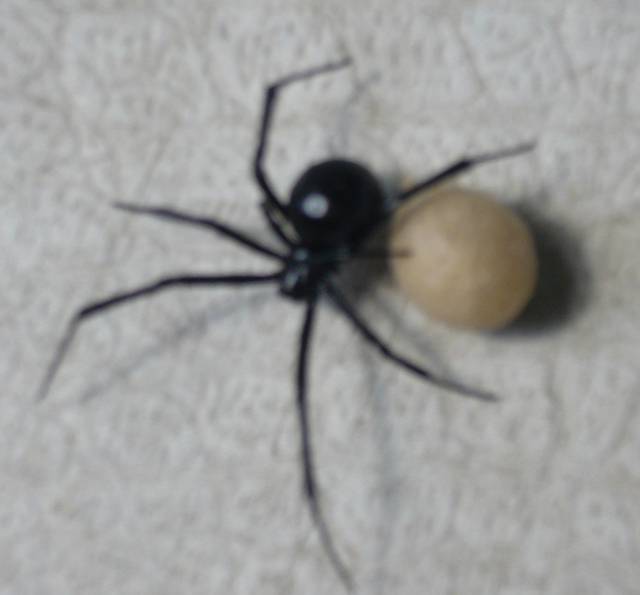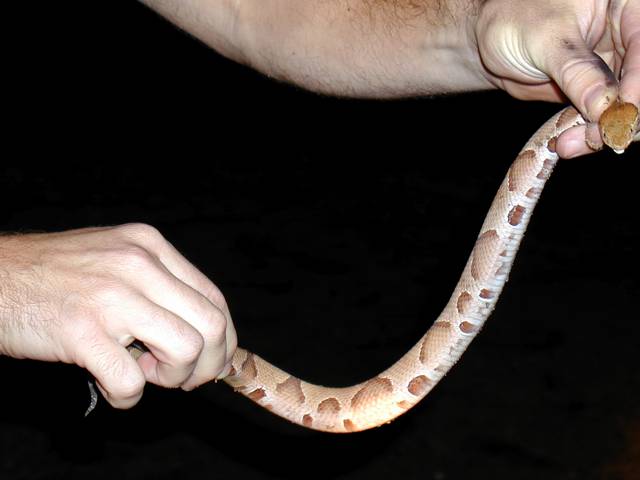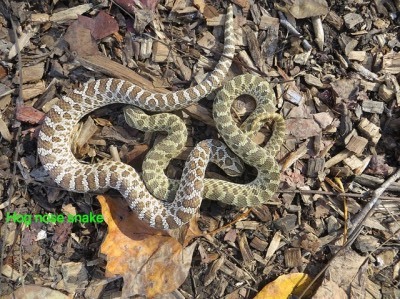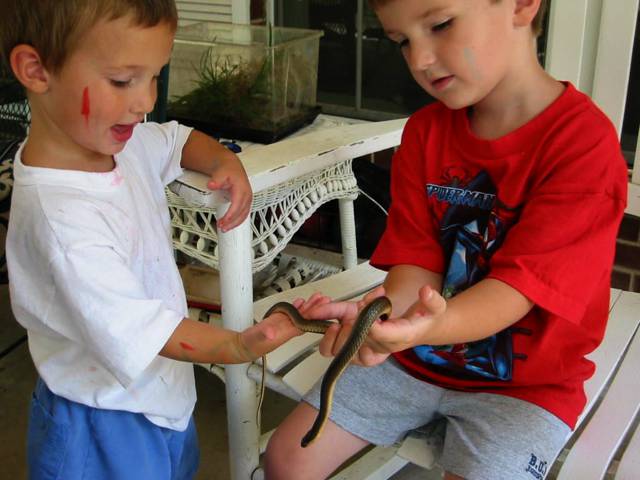Death by animals of any kind frightens a lot of people. Big predators like sharks and wolves are almost always near the top, but smaller animals such as snakes and spiders meet or exceed their ability to instill fear into humans. Let’s look at some of the statistics and reasons why.
Who’s Afraid of the Big Bad Wolf?
Wolves scare a lot of people. Novels and movies have been used for years to spread the fear, portraying wolves as a bad animal. Just to show you how horrible those wolves are, look at this picture of my wife meeting a wolf for the first time at a sanctuary in Colorado. Afterward, ask yourself “Who’s afraid of the big bad wolf?”
My Wife With a Wolf (below)
After you read this, you’ll realize our fear of wolves is unwarranted and results in the unnecessary killing of harmless wolves. Even the saying “who’s afraid of the big bad wolf?” is ingrained in society for wrong reasons.
The fear of death by animals isn’t restricted to wolves; they’re not the only ones unjustly accused and feared. I see a lot of posts on Facebook, and elsewhere, about people’s (unnatural) fear of snakes and spiders. There are often other reports of people (usually trophy hunters) killing wolves, lions, elephants, and other animals for the “sport” of it. I’ve also seen a lot of comments from people saying they kill any spider (or snake) they see before it harms them.
After twenty-five years of dealing with animals of all kinds, I know that snakes and spiders—or for that matter, animals in general—don’t intend to harm people, so I set out to find statistics. I gathered much of the information from the World Atlas site, which has amassed statistics on a variety of things.
Chart Showing Death by Animals (Various Ones)
Keep in mind that in the chart above (showing death by animals), the column representing deaths by humans, should be > 150,000. I couldn’t make the chart represent that because then nothing else would show. It would appear as if there were zero “death by animals” other than human. To further put that into perspective, the “human” column should be 150 times what is shown. To further put it in perspective, imagine a wolf being three feet high. If each human was also represented at that size, it would take a building 360 times as tall as the Empire State Building to represent the deaths by humans—in the US only. Now ask yourself “Who’s afraid of the big bad wolf?”
Let me show you using a simple table.
| wolves/sharks | snakes/spiders | bees/ants | cows/horses | dogs | humans |
|---|---|---|---|---|---|
| 2 | 13 | 15 | 22 | 25 | 150,000+ |
Remember, this chart represents only the United States. If we consider the whole world, the deaths caused by snakes jumps up significantly, and we need to add in deaths by other animals such as crocodiles, hippopotami, elephants, lions, and worst of all, the deaths from diseases spread by mosquitoes (number one killer), flies, worms, and snails.
The deaths shown by humans represent unnatural deaths, not deaths caused by disease or health problems. These are deaths represented by things such as: shootings, car accidents, homicides, human-on-human violence (war), and others.
Other Deaths (not animals)
According to the National Weather Service, an average of almost 30 people per year die from lightning strikes, putting the number of fatalities just behind floods and other weather-related disasters. I know that they’re not animals, but what it means is that you are about five times as likely to die from lightning as you are a snake or a spider—every year.
And since we’re talking about accidental deaths, you’re about 1,000 times as likely to die from a fall in the house (showers and tubs mostly) than a bite from a snake and several times those odds when it applies to wolves. So now who’s afraid of the big bad wolf?.
Animals that Draw the Most Hate
I want to talk a little more about a few of the animals that draw the most hate: spiders, snakes, sharks, and to a lesser extent wolves. All four of these combined don’t kill as many people as cows and horses or dogs. And humans kill ten thousand times more people (US statistic).
All of these deaths—the ones listed as ‘death by animals’—represent an average at a minimum of 10-12 years, and they were rounded up to the nearest whole number. For example, there have only been two deaths by wolves recorded in all of North America: one in Canada and one in Alaska. And that’s in more than a century. But it was averaged to one per year, which is greatly exaggerating it. Shark attacks are more frequent than that, but still not many. The New York Times reported in July 2008 that, on average, there were 16 shark attacks per year in the United States with one fatality every two years.
Deaths caused by car collisions with deer (for example) were not recorded because they were accidents. I’m sure the deer didn’t intentionally run into the car and try to kill a human. Deaths caused by driving under the influence were recorded because even though the death wasn’t intentional, the person should have known it was possible when driving under the influence.
Also note that the few deaths by snakes were more than likely caused by humans interfering with them (trying to catch or kill them). A snake doesn’t set out to attack a human. All they want is to be left alone.
That same line of reasoning applies to spiders. Despite what many people claim, spiders are not out to get you; in fact, they do much more good than people know. Consider this:
Spiders
House spiders typically eat indoor pests: flies, moths, roaches, mosquitoes, etc. If people would stop killing spiders indiscriminately, they would likely have far fewer problems with other pests. And spiders will not hunt you down and attack you; in fact, much like snakes, spiders go out of their way to avoid humans because like other species, they haven’t fared well.
Wolf Spider With Babies on Back (below)
Spiders may be the most misunderstood animal on this list, even more so than snakes. The picture above shows a wolf spider with babies on her back. The mother carries the babies on her back until they’re old enough to venture out on their own. If danger threatens, the babies will scurry off, then re-join the mother when it’s safe. The wolf spiders make excellent parents, better than many humans.
The one shown above was in our garage, and she’d been there for weeks.
Many people instinctively kill spiders because they fear the spiders will harm them. You are more likely to be killed by another human than a spider; in fact, according to statistics, you are about 23,000 times as likely in the United States. The statistics worldwide are slightly less but not much.
Spiders Are Not Out to Harm You
Spiders are not out to harm you. They dread encounters with humans because it almost never ends well for them. Even the dreaded “black widow” spider has no intention of biting humans. When bites do occur, it’s usually because she is trying to protect her egg sac and feels threatened. We have had an animal sanctuary for many years, and we see black widows all the time, but neither us nor any of the animals have ever been bitten; in fact, we have now relocated dozens of them to a spot deep in the woods.
And it’s easy to distinguish a black widow by the hourglass marking on her stomach. Below is a picture of one outside my office. The second picture shows one we ran into while cleaning the barn. She could have easily bitten us, but didn’t. All she wanted to do was guard her egg sac, which can be seen next to her.
Black Widow With Hourglass Marking (top pic)
Black Widow With Egg Sac (bottom pic)
Death by Animals (continued)
Snakes
Snakes are excellent for keeping certain pests under control, particularly rats and mice. We’ve had a couple of Texas rat snakes in our barn for years, and we do not have a rat problem.
Some snakes—like the California king snake—prey on other snakes, even venomous ones. The California king Snake is often mistaken for the coral snake because of similarities in the color markings, so unfortunately, it is killed. Another often misidentified snake is the hognose snake. It is common in most parts of the country, and it’s often mistaken for the venomous copperhead, but the hognose is harmless—even beneficial. Below is a picture of my son holding a copperhead which is venomous but seldom does harm; in fact, one time my wife was working in the garden not three feet away from a copperhead, and it never bothered her. She didn’t even know it was there until I spotted it tucked under a shrub.
Picture of Copperhead (below)
The hognose snake often plays dead and threatens attack by hissing. It does its best to frighten people and convince them it’s dangerous, but it’s not. All it wants to do, like all other snakes, is to be on its way and be left alone. Below are a few ways to properly identify a hognose snake:
- The nose is slightly turned up.
- Eyes have round pupils.
- If it feels threatened, it will spread its head by pressing against the ground, and it will usually put on an impressive hissing display.
- If that doesn’t work, it often plays dead. (It sometimes uses that as a first recourse.)
Picture of hognose snakes below.
Below is another example of how harmless most snakes are. I love my grandkids, and if I thought they would be in danger, I wouldn’t let this happen.
Grandsons Holding Earth Snake
We talked about statistics with spiders, but let’s take a look at the likelihood of death by animals listed compared to death by humans. Remember, this is United States only.
| Animal, average deaths | Likelihood of death by human |
|---|---|
| Wolf or shark | 150,000 X as likely |
| Spiders | 23,000 X as likely |
| Snakes | 25,000 X as likely |
| Bees or ants | 10,000 X as likely |
| cows or horses | 6,500 X as likely |
| dogs | 6,000 X as likely |
In 2016, there were 37,461 motor vehicle deaths in the USA. According to the Insurance Information Institute about 13,000 of them involved alcohol or drug-impaired drivers.
There were approximately 17,250 homicides in the US in 2016. That’s about 3,000 times as many deaths as were caused by snakes or spiders. And that’s just homicides.
And before you get up in arms about the high number of deaths by cows and horses, understand that they aren’t roaming the streets in gangs looking for trouble. The deaths attributed to those animals were accidents that happened while the person was working on the farm.
Dogs were the surprise on the list—not that there were so many but so few. According to statistics, we have about 90 million dogs in the US–90,000,000. And for the most part, they live closely with the roughly 350,000,000 humans. It’s not surprising there were so many deaths by dogs, but so few; in fact, I was shocked there were so few deaths from all the animals.
If you add up all the “death by animals” numbers they equal about 77 per year. We have about 220 times as many homicides each year—just homicides!
Summary
The next time you have a primal urge to kill something like a snake or a spider, perhaps you should kill a human instead. Perhaps we should change “Who’s afraid of the big bad wolf?” to “Who’s afraid of the big bad human?”
Suggestions
- If you come across a snake, even if you don’t know what kind it is—walk away. The snake won’t chase you; it will likely breathe a sigh of relief and go on its way.
- If you come across a spider while outside ignore it. If necessary, use a plastic cup or container to catch it and relocate it. If you see a spider inside your house, don’t panic. Almost all house spiders are good. Catch it in a container and relocate it to less-inhabited part of the house or outside if you must, though not all house spiders do well living outside.
I know not everyone will be comfortable with what I suggested, but give it a try. You might be surprised at how good you feel that you controlled your unnatural fear of something harmless and saved an animal’s life
If you enjoyed this post, please share.
Giacomo Giammatteo is the author of gritty crime dramas about murder, mystery, and family. And he also writes nonfiction books including the No Mistakes Careers series as well as books about grammar, publishing., and children’s fiction and nonfiction.
When Giacomo isn’t writing, he’s helping his wife take care of the animals on their sanctuary. At last count, they had forty animals—seven dogs, one horse, six cats, and twenty-five pigs.
Oh, and one crazy—and very large—wild boar, who used to take walks with Giacomo every day.
He lives in Texas where he and his wife have an animal sanctuary with forty loving “friends.”

